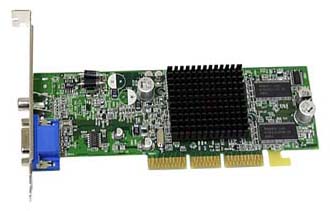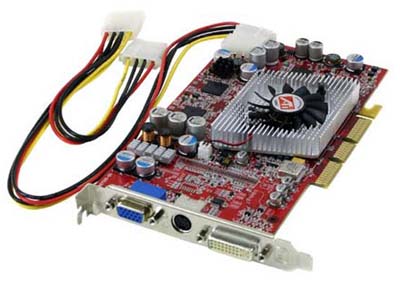Buyer's Guide - Entry Level, October 2004
by Jarred Walton on October 6, 2004 12:05 AM EST- Posted in
- Guides
Video Cards
We mentioned earlier on the motherboard selection that you might look for a solution with integrated graphics. We do not recommend it, but you can save about $20 should you choose to go that route. We prefer to go with an add-in graphics card and avoid integrated solutions. Part of the reason for this is drivers, since getting up-to-date drivers for integrated graphics solutions can often be difficult. It is easier to find drivers for Intel, NVIDIA, and ATI solutions, but the ATI and Intel options are currently only available for Pentium 4/Celeron platforms. However, we still prefer the quality and reliability of the discreet graphics cards manufactured by ATI and NVIDIA.
Office Graphics Recommendation: Celestica Radeon 9200SE 64MB DDR
Price: $35 shipped
The Radeon 9200SE continues to provide the best price for anyone looking for a cheap, but reliable, graphics card. Nearly all of the Radeon and GeForce graphics cards use the reference design, so quality and stability are very good. For non-gaming use, it really does not matter too much what type of graphics card you use. So, those who prefer something other than an ATI card might look to the GeForce 4MX cards or even FX5200 - although the latter costs a little more. Reliability of any of these cards is very good, as is the driver support. Just do not expect much in the way of performance should you try to fire up a 3D application.

Gaming Graphics Recommendation: Connect3D ATI Radeon 9800 Pro 128MB DDR, 256-bit
Price: $195 shipped
The price of our suggested "Budget Gamer" graphics card may seem somewhat out of line with the rest of the choices, but you really have to look at the bigger picture. With pretty much any moderate CPU, the bottleneck in games is going to be your graphics card. Personally, we would recommend that you save a bit of money on the CPU in order to upgrade your graphics card rather than the other way around. A P4 560 (3.6 GHz)/3500+ A64 processor will still struggle to run games when paired with a low-end graphics card, while a moderate 2.4 GHz Celeron D/2400+ Sempron will be sufficient for almost any game when paired with a mid-range graphics card. If you cannot afford $200 for a graphics card and you want to be able to play games for at least another year on your PC, you are better off saving up money for a few more months rather than settling for a cheaper alternative.
Within that $200 price range, there are many options for the budget gamer, and several new cards should be available within the next month that are worth waiting for. We are talking about the NVIDIA 6600GT and the ATI X700XT, which we have recently previewed. Unfortunately, you will need to wait for AGP versions if you want to stay with the rest of our budget configuration, which means that it might be two months or more before they are available. Of course, there is always something better coming out in the next few months - by the time the 6600 and X700 arrive, the latest buzz will be about the soon-to-be-released Spring graphics chips.
If you cannot wait that long and you still want a good gaming graphics card, the Radeon 9800 Pro continues to provide great performance for the price. Our initial previews of the 6600GT and X700XT show that while they will be generally faster than the 9800 Pro, the margin is not that great. This is not too surprising, considering that they all have eight pixel rendering pipelines. The 9800 Pro falls behind in core clock speed, but it makes up for it in memory bandwidth, resulting in relative performance that can fluctuate by up to 20% in either direction. Overall, the price is about the same on all the cards, but you can go out and purchase the Radeon 9800 Pro today.
Other options for the budget gamer include the 9600 Pro and 9600 XT, along with the FX5900 XT. Longevity is a pretty major concern with all of those, but they should suffice if you are not too demanding. If you are a more serious gamer and can actually spend the money, there are much faster cards available, which can improve performance further, but their prices do not fit the budget category. We recommend that you take a look at our other Buyer's Guides for further input.










53 Comments
View All Comments
JarredWalton - Monday, October 11, 2004 - link
52 - ??? If you have such a high-end graphics card, are you actually thinking about pairing it with a budget systesm? Anyway, yes, it should work, unless it's an AGP Pro graphics card and your motherboard doesn't have a Pro slot. A 550W PSU should be sufficient, regardless. Anyway, you ought to look into getting an Opteron, Athlon 64, or Pentium 4 to go with that card. :pnurazlanshah - Sunday, October 10, 2004 - link
can i use 3DLabs Wildcat Realizm 200 8x AGP 512MB G-DDR3 ($1500) with my NF2 8xagp motherboard even if i have 550w power supply?MasterFlash - Friday, October 8, 2004 - link
Nice article. I like your choice of components. My comp is similar to your recommendations: Antec SLQ-3700, Biostar MN7CD Pro mobo, Athlon XP 2500+, 2x512Mb DDR400 Crucial RAM, ATI Radeon 9800 Pro, 160Gb Seagate HDD, Toshiba DVD drive, generic 19" CRT.JarredWalton - Friday, October 8, 2004 - link
#49 - Foxconn and CasEdge have been suggested in our past budget guides, so I wanted to branch out a bit. :) I'm not too keen on their look, either, but that's just me.Bulldog66209 - Friday, October 8, 2004 - link
I've found that Foxconn/Supercase/CasEdge toolless cases offer good value, are easy to work with, and many are available with truly usable 400 watt power supplies. The local Micro-Center recently had a CasEdge TU-155 on sale for $31. The included power supply rated as capable of supplying 28 amps of 3.3V, 40 amps of 5V, and 17 amps at 12V at a nominal 400 watts. This compares favorably to the Antec which, although only rated at 350 watts, provides 28 , 35, and 16 amps.spartacvs - Friday, October 8, 2004 - link
To #41What the hell do you put on those HD? I have a 40Gb: few games, few applications, few videos, few mp3 and some small softwares (k9, avant browser, etc). It's only 2/3 full. And when it's 3/4 full, it just mean it's time for a little cleanup. Sure you can easily overload 2 x 120 Gb but your need are certainly not what most of the peoples needs.
mino - Friday, October 8, 2004 - link
#45 Nicely said.I completely agree,
It just seems to me it's very important to explicitly say what you mentioned here in your post.
It's beacause there is a HUGE amount of people who save those $20 or so, just because they have no idea what the result may be. The worst(not rare) case is, when such a person is a white-box builder...
Other than that I forgot to mention in my previous post that this guide is MUCH better then last one(not saying that was bad).
Keep good work Jarred.
And one suggestion for case to consider - since I think for value machine reliability is FAR more important than look - I recommend this YeongYang Cetus YY-5601 as an alternative with PSU I mentioned before.
We have been buying only these cases for a year now on and they ones of the best in $50-60 range.
they're available for inastance here http://store.yahoo.com/directron/yy5601.html
Ivo - Friday, October 8, 2004 - link
The review is very nice and useful but several additional aspects could be addressed too:1. The Video/Audio performance for 'Home entertainment' (without gaming - for older buyers :-).
2. The Cool & Quite (Eco) features of the components and systems.
3. The micro-ATX SFF systems (not barebones) for LAN-parties, Home-PCs etc.
4. The LCD-displays.
5. The long-term price (future software compatibility) of the systems.
In that sense, possibly, only systems with Athlon64 CPUs (with good cooler) are really interesting.
JarredWalton - Thursday, October 7, 2004 - link
Regarding several of the case comments, that's pretty much what I had in mind. I've built quite a few PCs for friends, family, and even myself. The downsides to the cheaper cases often more than outweigh the $20 or so you might save. Heck, if it were me, I would even try to get up to the SLK-3700 or Sonata cases by Antec (although oddly enough I prefer the 3700 over the Sonata - other than the PSU, of course). They're *so* much nicer to work with than a lot of the other sub-$100 cases.Really, cases are a personal choice. What I often consider gawdy or ugly, some people think is "l33t". Conversely, what I think is simple and elegant others will say is boring and dull. Buy what makes you happy, but if you get a cheap, generic PSU and it fails after a few months, don't say we didn't warn you!
Anyway, thanks to all for the kind comments. I'll look at including some other miscellaneous recommendations in the future. I do have to say that after reading Kris' MythTV articles, I've been itching to build a TiVo-esque PC. I just keep repeating to myselft, "You do NOT need another PC... you do NOT need another PC..." Heheh.
Neurorelay - Thursday, October 7, 2004 - link
Whoops, I see the 6600...okay, mistook the number. :)